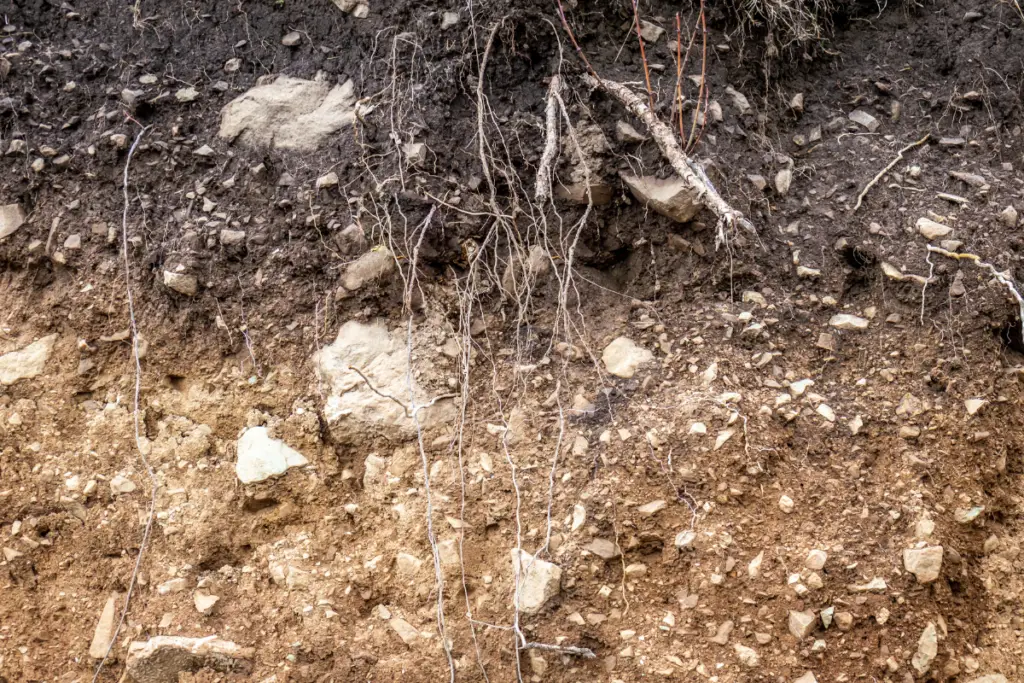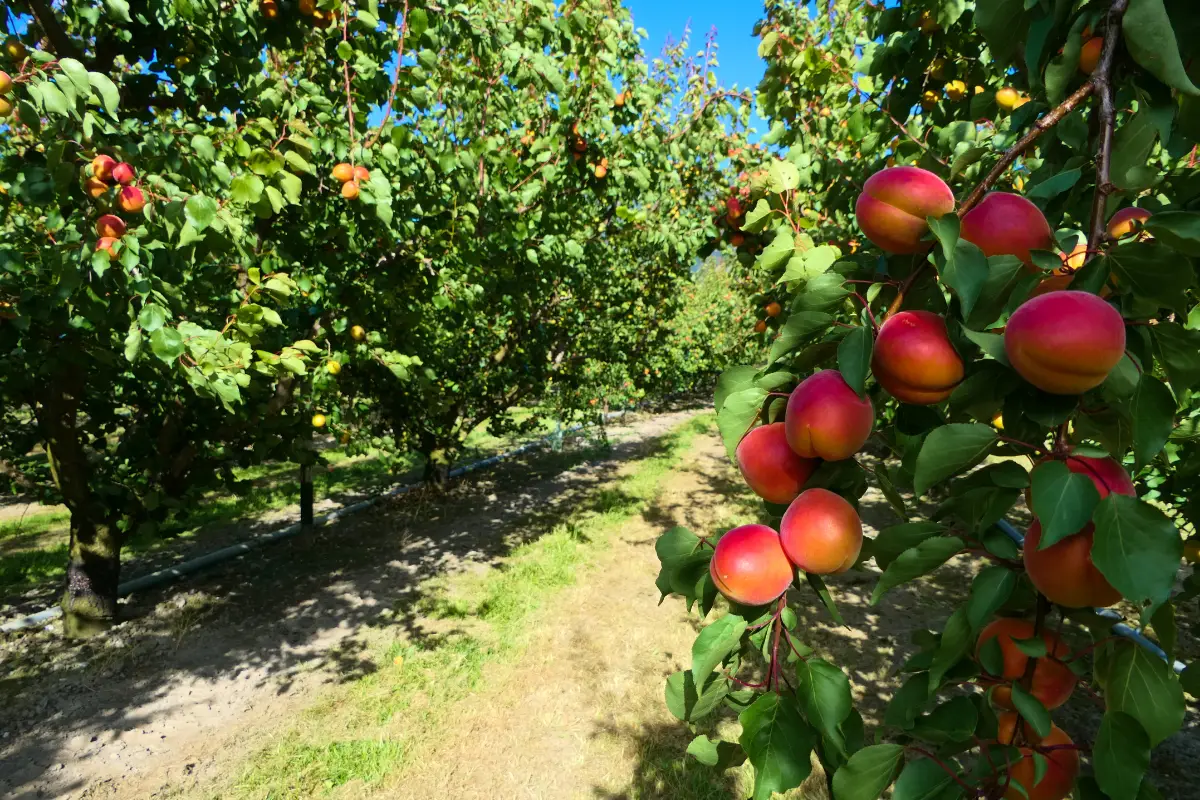Soil horizons are distinct layers of soil that are parallel to the soil surface. Each layer has unique physical, chemical, and biological characteristics that set it apart from the layers above and below it.
Soil horizons are formed over time as a result of various natural processes such as weathering, erosion, and organic matter decomposition.
There are generally six soil horizons, each with its own unique characteristics and properties.
The topmost layer is the O horizon, which consists of organic matter such as decomposing leaves and other plant debris.
Beneath the O horizon is the A horizon, which is also known as topsoil.
This layer is rich in organic matter and minerals and is where most plants grow.
The E horizon is a layer of leaching, where minerals and other materials are washed out of the soil.
The B horizon is a layer of accumulation, where minerals and other materials that have been leached out of the E horizon are deposited.
The C horizon is the layer of weathered parent material, and the R horizon is the layer of unweathered bedrock.
Understanding soil horizons is essential for farmers, gardeners, and other land managers.
By knowing the characteristics of each layer, they can make informed decisions about the types of crops to plant, the amount of fertilizer to use, and the best methods for managing soil health.
Soil horizons also play a crucial role in water filtration and nutrient cycling, making them an essential component of healthy ecosystems.

Table of Contents
Overview of Soil Horizons
Soil horizons are distinct layers of soil that form underground due to the combined actions of living organisms and percolating water.
These layers can be observed in a soil profile, which is a vertical section of soil that shows the different layers of soil horizons.
Soil scientists, also known as pedologists, study soil horizons to classify and interpret the soil for various uses.
There are six main soil horizons, which are divided into “Master Horizons” from top to bottom: O Horizon, A Horizon, E Horizon, B Horizon, C Horizon, and R Horizon.
Each of these horizons has unique characteristics that contribute to the overall health and productivity of the soil.
The O Horizon is the top layer of soil and consists of organic matter such as leaves, twigs, and other plant debris. It is also known as the “organic layer” and is important for soil fertility as it provides nutrients to plants and helps to retain moisture.
The A Horizon, also known as the topsoil, is the layer where most plant roots grow. It is rich in organic matter and microorganisms and is the most nutrient-rich and productive layer in a soil profile. The A Horizon is important for agriculture as it supports the growth of crops and other plants.
The E Horizon is a layer that is often found in forest soils and is characterized by the loss of minerals such as iron and aluminum. It is a light-colored layer and is often referred to as the “eluviated layer.”
The B Horizon, also known as the subsoil, is a layer that is rich in minerals and nutrients that have been leached down from the topsoil. It is important for plant growth as it provides essential nutrients and minerals.
The C Horizon is a layer that is composed of partially weathered rock and is often referred to as the “parent material.” It is important for soil formation as it provides the basis for the development of the other soil horizons.
The R Horizon is the bottom layer of soil and consists of unweathered rock. It is important for soil formation as it provides the foundation for the other soil horizons to develop.
Understanding the different soil horizons is important for soil management and conservation.
By studying soil horizons, soil scientists can determine the best practices for maintaining and improving soil health, which is essential for sustainable agriculture and environmental conservation.
Fundamentals of Soil Horizons
Soil horizons are layers of soil that develop from the combined actions of living organisms and percolating water.
These layers are distinguished by various properties, including color, texture, mineral content, and organic content.
The layers of soil are arranged in a vertical sequence, and each layer has a distinct set of characteristics that make it unique.
Formation Process
Soil horizons form through the process of weathering and soil development. Weathering is the process by which rocks and minerals are broken down into smaller pieces.
This process can occur through physical, chemical, and biological means. As rocks and minerals break down, they release nutrients that become available for plant growth.
Soil development occurs when weathered rock and mineral particles combine with organic matter and other materials to form soil.
The process of soil development is influenced by a variety of factors, including climate, vegetation, topography, and time.
Over time, the layers of soil become more distinct as different materials accumulate in each layer.
Composition
Soil horizons are composed of a variety of materials, including minerals, organic matter, water, and air.
The composition of each layer can vary depending on a variety of factors, including the type of rock or mineral that is weathering, the amount of organic matter present, and the amount of water that is present.
The O horizon, also known as the organic horizon, is composed of organic matter such as leaves, twigs, and other plant material. This layer is typically found on the surface of the soil and is important for nutrient cycling and soil fertility.
The A horizon, also known as the topsoil, is composed of a mixture of organic matter and mineral particles. This layer is typically the most fertile layer of soil and is where most plant roots are found.
The B horizon, also known as the subsoil, is composed of mineral particles that have been leached from the A horizon. This layer is typically less fertile than the A horizon and is where minerals such as iron and aluminum accumulate.
The C horizon, also known as the parent material, is composed of the original rock or mineral material that the soil formed from. This layer is typically not very fertile and is where the roots of most plants do not penetrate.
Types of Soil Horizons
Soil horizons are layers of soil that have unique characteristics and properties.
There are six main types of soil horizons, each with distinct characteristics and functions.
O Horizon
The O horizon, also known as the organic horizon, is the topmost layer of soil.
It is made up of decomposed plant material, such as leaves and twigs, and is dark in color due to the high concentration of organic matter.
The O horizon plays an important role in soil fertility by providing nutrients to plants and retaining moisture.
A Horizon
The A horizon, also known as the topsoil, is the layer below the O horizon. It is composed of mineral particles mixed with organic matter.
The A horizon is the most biologically active layer of soil and is crucial for plant growth.
It is typically darker in color than the lower layers due to the high concentration of organic matter.
E Horizon
The E horizon, also known as the eluviation layer, is the layer below the A horizon.
It is characterized by a loss of minerals, particularly clay and iron, which are leached out by water.
The E horizon is typically lighter in color than the A horizon due to the loss of minerals.
B Horizon
The B horizon, also known as the subsoil, is the layer below the E horizon.
It is composed of mineral particles that have been leached from the A and E horizons.
The B horizon is typically denser and less biologically active than the A horizon, but still plays an important role in plant growth by providing nutrients and water.
C Horizon
The C horizon, also known as the parent material, is the layer below the B horizon.
It is composed of unconsolidated material, such as rock fragments and weathered minerals.
The C horizon is the least biologically active layer of soil and has little direct impact on plant growth.
R Horizon
The R horizon, also known as the bedrock, is the layer below the C horizon.
It is composed of solid rock and is not considered part of the soil.
The R horizon has no direct impact on plant growth but can affect soil drainage and water availability.
Importance of Soil Horizons
Soil horizons are a crucial aspect of soil management. They provide valuable information about the soil’s physical, chemical, and biological properties.
Understanding soil horizons can help farmers and gardeners make informed decisions about soil management practices, such as crop selection, fertilization, and irrigation.
Here are a few reasons why soil horizons are important:
1. Soil Health
Soil horizons play a vital role in maintaining soil health.
Each horizon has a unique set of characteristics that influence the soil’s ability to support plant growth. For example, the topsoil (A horizon) is rich in organic matter and nutrients, making it the most fertile layer of the soil.
The subsoil (B horizon) is less fertile but has a higher clay content, which helps retain water and nutrients.
By understanding the different soil horizons, farmers and gardeners can develop soil management practices that promote healthy plant growth.
2. Environmental Sustainability
Soil horizons also play a critical role in environmental sustainability.
By maintaining healthy soil, farmers and gardeners can reduce the need for chemical fertilizers and pesticides, which can have negative impacts on the environment.
Additionally, soil horizons can help prevent soil erosion and runoff, which can lead to water pollution and other environmental problems.
3. Soil Classification
Soil horizons are also used to classify different types of soil. The USDA has developed a soil classification system based on the presence and characteristics of different soil horizons.
This system is used to identify different soil types and their suitability for different crops.
By understanding soil horizons, farmers and gardeners can make informed decisions about crop selection and soil management practices.
Soil Horizons and Agriculture
Soil horizons play a crucial role in agriculture. Understanding the different layers of soil and their properties is essential for farmers to optimize crop growth and yield.
Here are some ways soil horizons impact agriculture:
Nutrient Availability
Different soil horizons have varying nutrient contents. For example, the topsoil or A horizon is usually rich in organic matter, which provides essential nutrients to plants.
On the other hand, the subsoil or B horizon may have a lower nutrient content.
Farmers need to know the nutrient content of each soil horizon to determine the best fertilization strategy for their crops.
Water Availability
Soil horizons also affect water availability for plants. The topsoil or A horizon can hold more water than the subsoil or B horizon.
Farmers need to know the water-holding capacity of each soil horizon to determine the irrigation needs of their crops.
Soil Erosion
Soil erosion is a significant problem in agriculture. The loss of topsoil due to erosion can reduce crop yield and quality.
Understanding the soil horizons and their properties can help farmers implement erosion control measures such as planting cover crops, reducing tillage, and contour farming.
Soil Management
Different soil horizons have different properties that affect crop growth. For example, the C horizon may have a high clay content, which can affect root growth.
Farmers need to know the properties of each soil horizon to determine the best soil management practices for their crops.
Conclusion
In conclusion, understanding soil horizons is crucial for farmers, gardeners, and scientists to effectively manage soil health and productivity.
Each layer of soil has unique properties that affect plant growth and nutrient availability.
By knowing the characteristics of each horizon, farmers and gardeners can make informed decisions about fertilization, irrigation, and crop selection.
Scientists can also use soil horizons to study soil formation and the effects of human activities on soil health.
- How to Dry Basil Leaves: A Professional Guide
- Is an Avocado a Fruit or Vegetable? Simple Answer and Explanation
- Does Pineapple Have Seeds? Exploring the Anatomy of Pineapples
- Blooming Through Winter: Can I Grow Vegetables Indoors in the Winter?
- What Can You Grow in a Greenhouse All Year Round: A Guide to Year-Round Greenhouse Gardening
- Are Blueberries Blue? Debunking the Myth of Their Color
















